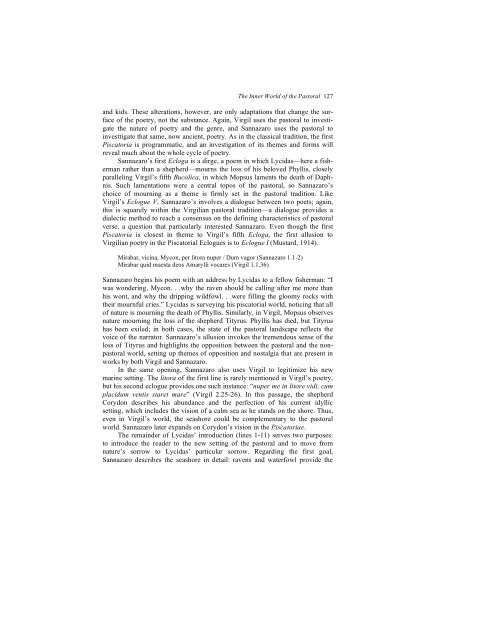Create successful ePaper yourself
Turn your PDF publications into a flip-book with our unique Google optimized e-Paper software.
The Inner World of the Pastoral 127<br />
and kids. These alterations, however, are only adaptations that change the surface<br />
of the poetry, not the substance. Again, Virgil uses the pastoral to investigate<br />
the nature of poetry and the genre, and Sannazaro uses the pastoral to<br />
investtigate that same, now ancient, poetry. As in the classical tradition, the first<br />
Piscatoria is programmatic, and an investigation of its themes and forms will<br />
reveal much about the whole cycle of poetry.<br />
Sannazaro’s first Ecloga is a dirge, a poem in which Lycidas—here a fisherman<br />
rather than a shepherd—mourns the loss of his beloved Phyllis, closely<br />
paralleling Virgil’s fifth Bucolica, in which Mopsus laments the death of Daphnis.<br />
Such lamentations were a central topos of the pastoral, so Sannazaro’s<br />
choice of mourning as a theme is firmly set in the pastoral tradition. Like<br />
Virgil’s Eclogue V, Sannazaro’s involves a dialogue between two poets; again,<br />
this is squarely within the Virgilian pastoral tradition—a dialogue provides a<br />
dialectic method to reach a consensus on the defining characteristics of pastoral<br />
verse, a question that particularly interested Sannazaro. Even though the first<br />
Piscatoria is closest in theme to Virgil’s fifth Ecloga, the first allusion to<br />
Virgilian poetry in the Piscatorial Eclogues is to Eclogue I (Mustard, <strong>19</strong>14).<br />
Mirabar, vicina, Mycon, per litora nuper / Dum vagor (Sannazaro 1.1-2)<br />
Mirabar quid maesta deos Amarylli vocares (Virgil 1.1.36)<br />
Sannazaro begins his poem with an address by Lycidas to a fellow fisherman: “I<br />
was wondering, Mycon. . .why the raven should be calling after me more than<br />
his wont, and why the dripping wildfowl. . .were filling the gloomy rocks with<br />
their mournful cries.” Lycidas is surveying his piscatorial world, noticing that all<br />
of nature is mourning the death of Phyllis. Similarly, in Virgil, Mopsus observes<br />
nature mourning the loss of the shepherd Tityrus. Phyllis has died, but Tityrus<br />
has been exiled; in both cases, the state of the pastoral landscape reflects the<br />
voice of the narrator. Sannazaro’s allusion invokes the tremendous sense of the<br />
loss of Tityrus and highlights the opposition between the pastoral and the nonpastoral<br />
world, setting up themes of opposition and nostalgia that are present in<br />
works by both Virgil and Sannazaro.<br />
In the same opening, Sannazaro also uses Virgil to legitimize his new<br />
marine setting. The litora of the first line is rarely mentioned in Virgil’s poetry,<br />
but his second eclogue provides one such instance: “nuper me in litore vidi, cum<br />
placidum ventis staret mare” (Virgil 2.25-26). In this passage, the shepherd<br />
Corydon describes his abundance and the perfection of his current idyllic<br />
setting, which includes the vision of a calm sea as he stands on the shore. Thus,<br />
even in Virgil’s world, the seashore could be complementary to the pastoral<br />
world. Sannazaro later expands on Corydon’s vision in the Piscatoriae.<br />
The remainder of Lycidas’ introduction (lines 1-11) serves two purposes:<br />
to introduce the reader to the new setting of the pastoral and to move from<br />
nature’s sorrow to Lycidas’ particular sorrow. Regarding the first goal,<br />
Sannazaro describes the seashore in detail: ravens and waterfowl provide the

















